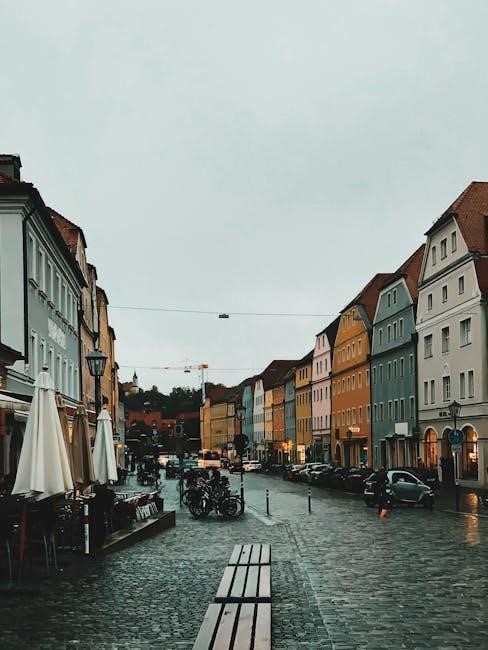Focal Path Guiding is an advanced technique enhancing light transport simulation efficiency by intelligently guiding high-contribution light paths‚ reducing noise and improving rendering accuracy in complex scenes.
Overview of Light Transport Simulation

Light transport simulation is a fundamental process in computer graphics that models how light interacts with various materials and environments. It is crucial for achieving realistic rendering in applications like films‚ games‚ and architectural design. The simulation involves tracing light paths as they bounce‚ scatter‚ or absorb within scenes‚ capturing complex interactions such as diffuse reflections‚ specular highlights‚ and translucency. Accurate light transport simulation enables the creation of visually convincing images‚ making it a cornerstone of modern rendering technologies.
Importance of Efficient Light Path Construction
Efficient light path construction is vital for accurate and performant rendering in light transport simulation. It ensures that the most significant light contributions are prioritized‚ reducing computational overhead and noise. By focusing on high-energy paths‚ rendering systems can achieve faster convergence and better image quality. This efficiency is critical for applications like real-time simulations and film production‚ where both speed and visual fidelity are essential. Optimized path construction directly impacts resource utilization and final output quality in complex scenes.
Definition and Purpose of Focal Path Guiding
Focal Path Guiding is a sophisticated technique designed to optimize light transport simulation by identifying and prioritizing significant light paths‚ known as focal points. Its primary purpose is to enhance rendering efficiency by concentrating computational resources on paths that most contribute to the final image. This method reduces noise‚ accelerates convergence‚ and improves visual accuracy‚ making it invaluable for real-time applications‚ film production‚ and architectural visualization where performance and precision are critical.

Fundamentals of Light Transport Simulation
Light transport simulation involves the propagation and interaction of light within a scene‚ enabling accurate rendering of lighting effects through techniques like path tracing and photon mapping.

Basic Principles of Light Propagation
Light propagation follows physical laws‚ including reflection‚ refraction‚ and diffraction‚ governed by the Bidirectional Reflectance Distribution Function (BRDF). These principles determine how light interacts with materials and geometry‚ influencing final renderings. Understanding these fundamentals is crucial for accurate light transport simulation‚ enabling realistic rendering of scenes with complex lighting effects.
Path Tracing Algorithms in Light Transport
Path tracing algorithms simulate light transport by tracing light paths from the camera through scenes‚ accounting for interactions with materials and geometry. These algorithms solve the rendering equation by sampling light paths‚ considering reflections‚ refractions‚ and emissions. By evaluating contributions from all paths‚ they achieve accurate and realistic rendering. Path tracing is foundational for many rendering techniques‚ enabling the simulation of complex light interactions and providing high-quality visual results in various applications.
Challenges in Simulating Complex Light Interactions
Simulating complex light interactions presents significant challenges due to the intricate nature of light propagation and scattering. Scenes with multiple materials‚ occlusions‚ and indirect lighting require extensive computational resources. Additionally‚ accurately capturing high-contribution light paths while managing noise and convergence issues is difficult. These challenges demand advanced algorithms to efficiently handle the complexity‚ ensuring realistic rendering without excessive computational overhead‚ while maintaining image quality and accuracy.
Challenges in Light Transport Simulation
Light transport simulation faces challenges like computational complexity‚ noise in path tracing‚ and difficulty in sampling high-contribution paths efficiently‚ requiring advanced techniques for accurate results.
Computational Complexity and Resource Demands
Light transport simulation requires significant computational resources due to the intricate calculations involved in tracing light paths and interactions within complex scenes. The sheer number of light paths‚ combined with the need for precise geometric and material interactions‚ leads to high processing demands. Scenes with complex geometries‚ volumetric effects‚ or indirect lighting further exacerbate these challenges. This makes efficient algorithms and optimized hardware crucial for achieving realistic results without excessive rendering times or resource consumption.
Noise and Convergence Issues in Path Tracing
Path tracing often struggles with noise due to the stochastic nature of Monte Carlo sampling‚ leading to grainy images‚ especially in complex scenes. This variance is amplified in indirect lighting and materials with high specular properties‚ requiring more samples for acceptable results.
Convergence issues arise as scenes grow complex‚ with materials like glass or metal exacerbating the problem. Achieving noise-free images demands increased computational effort‚ highlighting the need for efficient techniques to balance quality and performance in light transport simulation.

Difficulties in Sampling High-Contribution Light Paths
Sampling high-contribution light paths is challenging due to their rarity and significant impact on image quality. These paths‚ often involving specular materials or complex geometries‚ are hard to capture stochastically‚ leading to inefficient sampling. Traditional methods struggle to identify and prioritize these paths‚ resulting in poor convergence and increased noise in critical areas. This inefficiency underscores the need for advanced techniques like focal path guiding to effectively target and sample these high-value paths‚ ensuring accurate and efficient light transport simulation.

What is Focal Path Guiding?
Focal Path Guiding is a technique that enhances light transport simulation by intelligently guiding sampling toward high-contribution light paths‚ improving rendering efficiency and accuracy in complex scenes.
Definition and Core Concepts
Focal Path Guiding is a sophisticated technique designed to optimize light transport simulation by intelligently identifying and sampling high-contribution light paths. It leverages adaptive strategies to focus computational resources on paths that significantly impact the final image‚ reducing noise and improving convergence. Unlike traditional methods‚ it dynamically adjusts sampling based on scene complexity and light interaction‚ ensuring efficient rendering even in intricate environments. This approach enhances accuracy and performance in simulating realistic light behavior.
Key Differences from Traditional Path Guiding
Focal Path Guiding differs from traditional methods by its adaptive‚ dynamic approach to light path sampling. Unlike static or heuristic-based techniques‚ it prioritizes paths based on real-time scene analysis and contribution potential. This reduces noise and accelerates convergence. Focal Path Guiding also integrates with modern computational advances‚ such as machine learning‚ to enhance accuracy and efficiency. Its ability to handle complex interactions without extensive precomputation makes it more versatile and effective in demanding scenarios.
Advantages of Focal Path Guiding
Focal Path Guiding offers significant advantages in light transport simulation‚ including improved rendering efficiency and reduced computational demands. It excels at minimizing noise in complex scenes while maintaining high accuracy. By focusing on high-contribution paths‚ it accelerates convergence and enhances image quality. Additionally‚ its adaptive nature allows it to handle intricate lighting interactions more effectively than traditional methods‚ making it a powerful tool for realistic and detailed visualizations in various applications.
Key Concepts in Focal Path Guiding
Focal Path Guiding revolves around identifying high-contribution light paths‚ using adaptive sampling techniques to optimize rendering efficiency and accuracy in complex scenes.
Importance Sampling in Light Transport
Importance sampling is a critical technique in light transport simulation‚ prioritizing paths contributing significantly to image formation. By focusing on high-energy light paths‚ it reduces computational effort and noise‚ accelerating convergence. This method ensures efficient resource allocation‚ improving rendering accuracy and performance in complex scenes. It is foundational to focal path guiding‚ enabling smarter path construction and sampling strategies. Proper implementation enhances overall simulation efficiency‚ making it indispensable in modern rendering algorithms.
Identifying Focal Points for Guided Sampling
Identifying focal points involves detecting critical regions in a scene where light contributes significantly to the final image. Focal path guiding uses intensity‚ reflected light patterns‚ and geometric properties to pinpoint these areas. Advanced algorithms analyze flux distribution and gradient metrics to determine high-contribution paths. This targeted approach ensures efficient sampling‚ reducing noise and improving convergence. By prioritizing these focal points‚ simulations achieve higher accuracy and realism‚ making it a cornerstone of modern light transport techniques.
Adaptive Path Construction Techniques
Adaptive path construction techniques dynamically adjust light path sampling based on scene complexity and light intensity. These methods use real-time feedback to identify and prioritize high-contribution paths‚ ensuring efficient resource allocation. By leveraging intensity gradients and flux distributions‚ focal path guiding adaptively refines sampling strategies. This approach minimizes variance and accelerates convergence‚ particularly in complex scenes with challenging light interactions. The result is faster rendering while maintaining high visual fidelity‚ making it invaluable for both real-time and offline applications in computer graphics.

Implementation of Focal Path Guiding
Focal Path Guiding’s implementation involves integrating advanced sampling algorithms into light transport frameworks‚ leveraging focal points to enhance rendering efficiency and accuracy in complex scenes.
Algorithmic Framework for Focal Path Guiding
The algorithmic framework for Focal Path Guiding involves identifying key focal points in scenes and guiding light path sampling toward these areas. It uses advanced importance sampling techniques to prioritize paths contributing significantly to image formation. The framework iteratively refines path construction‚ balancing exploration and exploitation to optimize rendering efficiency. By focusing on high-contribution paths‚ it reduces variance and noise‚ enabling faster convergence in complex light transport simulations while maintaining accuracy and realism.
Practical Steps for Integrating Focal Path Guiding
Integrating Focal Path Guiding involves identifying scene focal points and adapting sampling strategies. Start by analyzing the scene to detect high-contribution areas. Implement importance sampling to prioritize these regions. Use iterative path refinement to balance exploration and exploitation. Integrate with existing path-tracing algorithms to maintain compatibility. Monitor performance and adjust parameters for optimal efficiency. Regularly update sampling distributions to adapt to scene dynamics. Ensure robust implementation to handle complex light interactions effectively.
Optimizing Performance in Real-World Scenarios
Optimizing Focal Path Guiding in real-world scenarios involves balancing computational efficiency with visual accuracy. Scenes with complex geometry or dynamic lighting require adaptive sampling strategies. Prioritize focal points to reduce noise in high-contribution areas while maintaining detail. Implement scene-specific optimizations to handle large-scale environments. Use hybrid rendering techniques to combine focal guiding with traditional methods for consistent results. Regularly benchmark performance to identify bottlenecks and refine parameters for optimal execution. Ensure seamless integration with existing pipelines to maintain production-ready efficiency and scalability.

Applications of Focal Path Guiding
Focal Path Guiding enhances rendering efficiency in computer graphics‚ film‚ and architectural visualization‚ enabling realistic light simulation in complex scenes and real-time applications.
Improving Rendering Efficiency in Computer Graphics
Focal Path Guiding significantly enhances rendering efficiency by prioritizing high-contribution light paths‚ reducing noise‚ and accelerating convergence in complex scenes. This technique optimizes light transport simulation‚ enabling faster and more accurate results in computer graphics. By focusing on critical light interactions‚ it minimizes unnecessary computations‚ making it particularly effective for scenes with intricate geometries and diverse material properties. This improvement is crucial for real-time applications and high-performance rendering systems.
Enhancing Real-Time Light Transport Simulation
Focal Path Guiding revolutionizes real-time light transport simulation by accelerating the rendering process and improving visual fidelity. By intelligently guiding light paths‚ it reduces computational overhead and enhances performance in dynamic scenes. This technique is particularly beneficial for applications requiring fast rendering‚ such as virtual reality and interactive simulations. Focal Path Guiding ensures that critical light interactions are prioritized‚ enabling realistic and efficient real-time light transport simulation‚ even in complex environments with moving objects and changing illumination conditions.

Use Cases in Film and Architectural Visualization
Focal Path Guiding significantly enhances realism and efficiency in film and architectural visualization by accurately simulating complex light interactions. In film production‚ it enables the creation of detailed‚ dynamic lighting effects for scenes with intricate geometries and materials. For architectural visualization‚ it facilitates realistic lighting simulations‚ aiding in the design and presentation of spaces with precise light behavior. This technique is invaluable for achieving high-fidelity visuals while optimizing rendering performance in both industries‚ making it a cornerstone of modern visual production workflows.
Future Trends and Research Directions
Future research in focal path guiding may focus on integrating machine learning for enhanced performance‚ developing adaptive algorithms‚ and exploring real-time applications in immersive technologies and gaming.
Emerging Techniques in Light Transport Simulation
Emerging techniques in light transport simulation focus on machine learning and AI-driven methods to optimize path sampling. These approaches enable adaptive sampling strategies and advanced path guiding algorithms. Researchers are also exploring real-time applications‚ integrating focal path guiding with other methods like Monte Carlo and Metropolis sampling. Such innovations aim to enhance rendering efficiency and accuracy‚ particularly in complex scenes with high-contribution light paths; These advancements promise to revolutionize the field‚ offering faster and more robust light transport solutions for various industries.
Advancements in Focal Path Guiding Algorithms
Recent advancements in focal path guiding algorithms focus on improving sampling efficiency and reducing variance in complex light transport scenarios. Inspired by existing path-guiding techniques‚ these algorithms incorporate machine learning to iteratively learn high-contribution light paths. They enable adaptive sampling strategies‚ prioritizing focal points that significantly impact image quality. Such advancements ensure faster convergence and more accurate rendering‚ even in scenes with challenging light interactions. These improvements are particularly beneficial for real-time applications and large-scale simulations‚ enhancing overall performance without compromising visual fidelity.
Integration with Machine Learning for Enhanced Performance
The integration of machine learning with focal path guiding has revolutionized light transport simulation by enabling adaptive sampling strategies. By training models to predict high-contribution light paths‚ algorithms can focus on the most significant routes‚ reducing noise and computational overhead. This synergy allows for real-time rendering optimizations and improved accuracy in complex scenes. Machine learning also enhances the ability to dynamically adjust sampling priorities‚ making simulations more efficient and scalable for modern applications.
Focal path guiding revolutionizes light transport simulation by enhancing efficiency‚ reducing noise‚ and ensuring accurate rendering. Its impact on future simulations is both profound and promising.
Focal Path Guiding significantly improves rendering efficiency by reducing variance and noise in light transport simulations. It enhances accuracy by prioritizing high-contribution paths‚ ensuring realistic results. The technique adaptively samples critical light interactions‚ accelerating convergence while maintaining image quality. By focusing on focal points‚ it optimizes resource allocation‚ making it highly effective for complex scenes. Overall‚ Focal Path Guiding offers a robust solution for balancing performance and visual fidelity in modern rendering applications.
Impact on the Future of Light Transport Simulation

Focal Path Guiding is poised to revolutionize light transport simulation by enabling faster‚ more accurate rendering in real-time applications. Its adaptive sampling and reduced variance will drive advancements in virtual reality‚ gaming‚ and cinematic rendering; Integration with machine learning promises further efficiency gains‚ automating path optimization. As the technique evolves‚ it will become indispensable for achieving photorealistic results in complex scenes‚ ensuring its pivotal role in shaping the future of computer graphics and immersive technologies.

